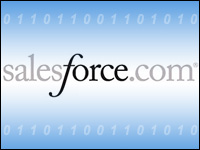
Salesforce.com is having a good year this quarter. That’s not a typo — the company seems to be announcing a year’s worth of new products in a very short time, though delivery for some of the announcements might stretch out to this time next year.
This week, Salesforce announced what I think of as the other shoe, or the business side of the AppExchange and associated infrastructure.
So far, the focus has been primarily on Salesforce’s novel approach to building and deploying business applications, and, while it is important, that discussion does not lead directly to revenues. As a result, Salesforce has pulled together the business implications of its new technology into a package that will appeal to Wall Street.
Concept-to-Cash
The AppStore, the focus of the announcement, is both an acknowledgment that the original focus of the AppExchange — build it and they will come — is just a tad ambitious and a segmentation of the business process into very traditional parts like sales, delivery, invoicing and collection. Taken together, they have fully automated and made on-demand the concept-to-cash business process, something every company needs and few have integrated to such an extent.
The first impression I had when briefed on the AppStore was how conventional it all is; nevertheless, it’s this conventional piece that emerging companies frequently get wrong. The AppStore and everything it connects is not very groundbreaking as a business proposition. In fact, it is conservative — it’s called vertical integration.
Consider the Pieces
Idea Exchange captures customer wish list ideas for new applications.
Apex has been designated as the development language, though as a language it is insufficient to stand on its own. For full application you need development, extension, and all the rest of the tools, but this is quibbling. Suffice it to say that the development box has been checked off.
In a slight change, the company now positions the AppExchange as a marketing tool and separates other important parts of the application sales process to the upcoming AppStore, they said this week.
The Partner Program
The business process is not the only thing conforming to traditional business norms — so is the partner program. There are three levels to the new program, which offers partners marketing assistance, lead sharing, and direct contact with Salesforce’s field sales force — for a price.
The price ranges from free to 10 percent or 25 percent of the price that partners charge for their applications. That is on top of the additional seat licenses that Salesforce will automatically sell to make those seats viable for presumably new users. Coming next December, Salesforce will offer to take over the billing and collection from any partner that effectively develops a solution, drops it on Salesforce’s door step and heads for the beach.
There were two channel models that could have been employed here: either sell the OEM product at a discount to the reseller who marks it up, or charge a markup back. As Salesforce is doing the marketing, selling, hosting and everything else, it makes more sense to construct the model as it has. With Salesforce handling the receivables, the partners will simply receive a check net of Salesforce’s part.
Not All Smooth Sailing
There will be challenges and adjustments for the new model. For one thing, there is no runtime license, which will probably be addressed in the new year. Without a runtime license, a company would need to pay for a full seat subscription for any new user brought on to use one specific, non-Salesforce application.
That situation represents a challenge for Salesforce. Certainly, customers running applications other than the core CRM suite deserve some price relief, but the vendor has a right and a need to charge for the infrastructure being used, as well. Sometime early in 2007, look for Salesforce to come out with a way of segmenting users into different classes for the purpose of assigning a value to the runtime subscription.
Some of what Salesforce has announced — specifically the AppStore Checkout Partnership — will not hit the market until December 2007, a long time in this business; however, one suspects the announcement of everything at once was required by the scope of the undertaking. The analogy I see is with the announcement of FedEx more than 20 years ago. Like a prime number, the system can not really be factored into smaller units.
The Bottom Line
Finally, let’s consider what this means in the big scheme of things. There is now the capability to, at least in theory, build any business application and deliver it on-demand such that the new application is fully integrated out of the box (or off the wire) with anything else in a rapidly growing suite.
Also, there is now, or will be about the time we get back to real work in 2007, a more or less complete facility to identify, test, install, purchase, pay for and receive support and maintenance online.
Salesforce has developed a full function business software utility, and with it an economy or ecosystem of builders, buyers, and sellers that spans the planet. Good for them, but now the hard part starts.
Up to now, the market and Salesforce have been focused on replacing the tired infrastructure that supported building and buying software licenses. With that out of the way, much more attention will need to be focused on leveraging software to do better business.
There has never been a time when the old IT adage and acronym, GIGO (Garbage In, Garbage Out), had greater potential resonance. If we can keep ourselves from building every poor application possible simply because it is easy to do so, it will be because vendors develop and market practical or subject matter expertise regarding business processes.
The next big challenge that I see involves business process management. Software had been a limiting factor for many business processes, in part because the process and practices were inextricably tied together. In the future, process and practice will be separate and a door will open for a different kind of IT or business consulting.
It is now time for software companies to change focus to take advantage of the new opportunities.
Denis Pombriant runs the Beagle Research Group, LLC, a CRM market research firm and consultancy. Pombriant’s research concentrates on evolving product ideas and emerging companies in the sales, marketing, and call center disciplines. His research is freely distributed through a blog and Web site. He is working on a book and can be reached at [email protected].






















































